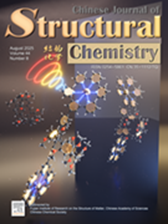
Cover Picture
Metal-coordinate complexes (M = 3d, 4f) with enhanced circularly polarized luminescence in planar chiral pillar[5]arenes
Yu Tian, Yijun Lin, Siyu Deng, Yinghe Tan, Xuanyi Bie, Zhaoyang Chen, Pangkuan Chen* Submit a Manuscript
Metal-coordinate complexes (M = 3d, 4f) with enhanced circularly polarized luminescence in planar chiral pillar[5]arenes
Yu Tian, Yijun Lin, Siyu Deng, Yinghe Tan, Xuanyi Bie, Zhaoyang Chen, Pangkuan Chen* Submit a Manuscript
Optimizing the Schottky barrier in AuAg alloy decorated TiO2 nanofibers to enhance hot-electron-induced CO2 reduction
Na Lu, Tingting Pang, Xuedong Jing, Yongan Zhu, Linqun Yu, Sining Ben, Yuchan Song, Shiwen Du, Wei Lu, Zhenyi Zhang*
Chin. J. Struct. Chem., 2025, 44(8), 100633. DOI: 10.1016/j.cjsc.2025.100633
August 1, 2025
Photocatalysis; Plasmonic hot-electron injection; Schottky barrier; AuAg alloy; CO2 reduction
ABSTRACT
Plasmon-induced hot electron can transfer from noble metal to its cohesive semiconductor in their heterostructure to initial the photocatalytic reaction upon resonance excitation. However, the co-excitation of semiconductor in the heterostructure would also lead to the inversus transfer of photo-electron from semiconductor to noble metal, which inevitably limits the use of active electrons. Herein, we demonstrate that after co-excitation of both the localized surface plasmon resonance (LSPR) of noble metal and the interband transition of semiconductor, the interfacial electron transfer process strongly depends on the energy band configuration of their heterostructure. When the Au content in the AuAg alloy nanoparticles (NPs) was changed from 0 to 100 at.%, the interfacial energy band configuration at AuAg NPs/TiO2 NPs in the electrospun nanofibers (NFs) shifted from Ohmic to Schottky contacts. Further investigation found that the optimal Schottky barrier configuration in the Au0.25Ag0.75/TiO2 NFs can not only boost the plasmon-induced hot electron transfer from Au0.25Ag0.75 to TiO2 NPs but also suppresses the backflow of photo-electrons from TiO2 to Au0.25Ag0.75 NPs in the NFs. Thus, upon UV-visible light irradiation, the CO2 photo-reduction activity of the Au0.25Ag0.75/TiO2 NFs was ∼3 and ∼2 times higher than that of either Ag/TiO2 or Au/TiO2 NFs.







